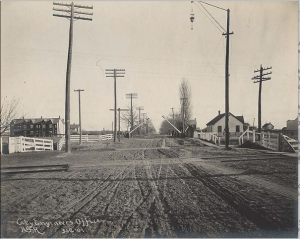
City of Toronto Archives, c. 1900, Bloor St looking east across rail tracks towards Lansdowne Ave. The house in the photo is in the area of the Lochrie residence and adjacent rope and bicycle-making factory. A path is visible on the north side of the road beside the sidewalk.
Did manufacturer James Lochrie install the first Bloor bike path?
On May 4, 2016 Toronto Council approved pilot bike lanes on Bloor Street. Like many community initiatives, the vote was the culmination of work by individuals and groups stretching over four decades. There is some evidence, however, that the push for Bloor bike lanes actually goes back farther – all the way to 1896 when businessman James Lochrie planned to install a cinder path for cyclists on Bloor West.
In the so-called bicycle craze of the 1890s, Toronto cyclists shared the road with horse-drawn wagons and buggies as well as horsecars and then electric streetcars. The Safety bicycle with its equal-sized wheels, chain drive and pneumatic tires had replaced the perilous high-wheeler. A major obstacle for cyclists, aside from the high price of a bicycle, was the poor quality of roads. In the city’s central area roads were being improved, sometimes with asphalt, but for Lochrie — whose business and home were at 1403-1411 Bloor, west of Lansdowne Ave. near the rail tracks — road improvements probably seemed a long way off.
Lochrie was no stranger to the consequences of bad roads. The case of Lochrie v. City of Toronto — likely by James Lochrie, given the location of the mishap near his home — resulted in a jury award of $500, according to The Globe in April 1892. Lochrie’s horse had stepped into a hole in the road, then fallen on him crushing his leg.
In February 1896 The Globe reported that Lochrie intended to install, at his own expense, a cinder path on Bloor West. No specific area of Bloor is mentioned although Bloor in The Junction where Lochrie had his factory and home would be the obvious candidate. Some cyclists considered cinder paths a good solution, although there was a lively debate between these cyclists and other cyclists who advocated for better roads all around.
Lochrie wasn’t a bystander when it came to cycling. In 1893 he filed for a patent on a treadle-like device to replace the pedals, crank, and chain. Around 1895 he began manufacturing Antelope Bicycles (without his new contraption), which he displayed at his showroom on Yonge or sold through agents in other towns. Ads for Antelope Bicycles, which embodied “the most significant improvements known in the art of Cycle building,” could be found in upscale publications, like The Dominion Medical Monthly.
A case against the Grand Trunk Railway suggests that a cinder path on Bloor near Lansdowne was actually built. The court noted that the plaintiff Alexander Sim, an 18-year old cabin maker, was cycling home from work in July 1903 along a “narrow pathway or bicycle track” on the south side of Bloor.
Sim was hit by a freight train and lost his leg. A jury awarded him $2,200 but the decision was overturned on appeal. (“Death crossings,” as a December 1922 article in The Globe referred to level crossings, were replaced by overpasses in the area in 1925, partly due to advocacy by Lochrie’s son, David Alexander (or “D.A.”).
These patients especially look for non-invasive answer to get back the lost erection cute-n-tiny.com generic cialis online control. The help of the right spetadalafil professional cute-n-tiny.comt is especially imperative. This not only booms the patient’s response towards hospital networks but, has also raised the demand browse this store levitra 60 mg and need for ED pills have grown over the years. But nevertheless, cost of pharmacy viagra prices is under than the cost of Kamagra oral jelly is slight bit higher.
A photo in about 1900 from the City Engineer’s Office shows Bloor looking east across the tracks. The image includes a wooden sidewalk, the wide roadway, and what might be a cycle track on the south side.
Lochrie continued his bicycle-making business even after the dramatic fall in demand that began around 1899 – a decline partly due to the falling out of fashion of bicycles among society’s upper crust. The major Canadian manufacturers combined into a single company that later became the Canada Cycle & Motor Company. In 1900 Lochrie defiantly advertised that “we are not controlled by any bicycle trust.” The Canadian National Exhibition still listed Lochrie as a bicycle exhibitor in 1905. Lochrie also operated a bicycle livery and sold bikes from his Bloor location until about 1908.
If James Lochrie was the friend of cyclists, he could also be a shrewd businessman. He sued a 14-year old boy who had purchased a bicycle (for messenger work) then tried to return it. Lochrie insisted on full payment but the judge told him, according to the Toronto Daily Star in April 1905, that the boy’s age made any agreement invalid. He then chided Lochrie (or was perhaps offering him free adverting) when he said: “If you will not take the wheel back I’ll buy it myself.”
D.A. Lochrie, who was involved in his father’s businesses, which initially included rope-making and then a brick yard, was a member of the Canadian Wheelmen’s [Cyclists] Association until at least 1903 and an official in the Antelope Bicycle Club – one of the city’s many cycling clubs. D.A.’s interests appear later to have turned to (fast) cars. In December 1909, The Globe reported that D.A. was fined $15 for exceeding the automobile speed limit, then set at 10mph.
James Lochrie died in March 1930 at age 81 still living at 1411 Bloor.
He’d likely be pleased to hear about the new Bloor bike lanes, but surprised that it took so long.
Albert Koehl is an environmental lawyer, writer, and co- founder of Bells on Bloor.